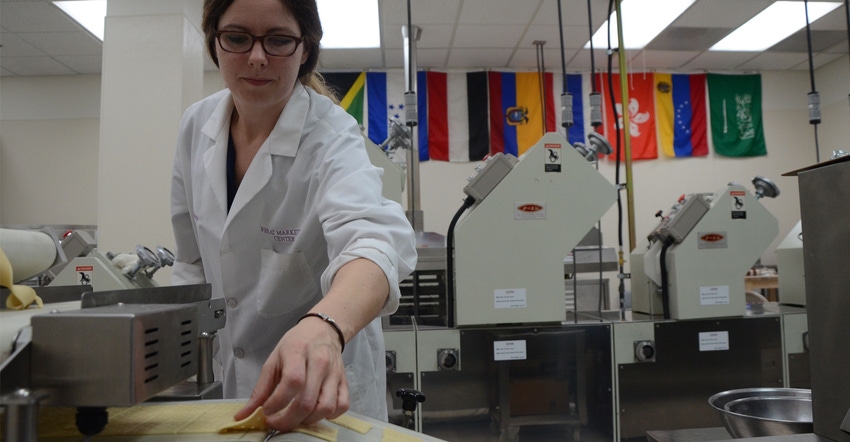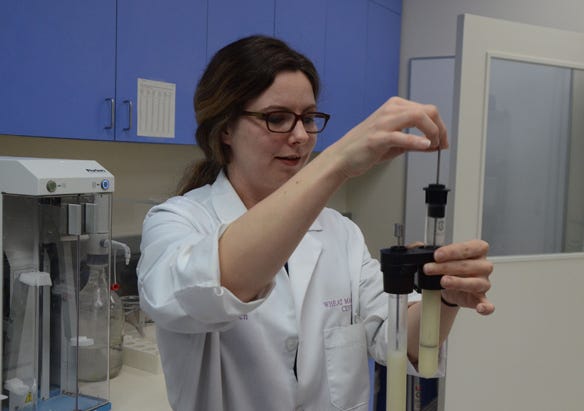
Terms like "rollability," "slurpability" or "stackability" might not sound like real words, but at the Wheat Marketing Center in Portland, Ore., they're actually measurements for different characteristics of wheat-based products like tortillas, noodles and crackers.
Based in the Albers Milling Co. building in Portland's historic Pearl District, the Wheat Marketing Center tests all six market classes of wheat from flour to end product — and that includes everything from breads to crackers to cookies to tortillas to flatbreads.
Founded by wheat commissions from Oregon, Washington, Idaho, Montana, Nebraska, North Dakota and Colorado, the goal is to help expand marketing opportunities by improving end product quality and showing customers how to use U.S. wheat successfully.
As part of this ongoing effort, the center has recently focused on market opportunities for different blends of flour, as well as whole-wheat products. "You can't just test grain; you have to make the end product. It's about understanding how wheat is going to perform, so we can share that information with our customers," says Janice Cooper, the center's managing director. "It's a micro-production scale that allows us to test different flavors and ingredients."
Whole-wheat opportunities
Blending is a big piece of the puzzle for exports, and the center has been working closely with international markets to find blends that work for their price range and end uses.
For example, Nigeria is a significant importer of wheat, importing about $1 billion worth of wheat annually, most of it from the U.S. However, when wheat prices increased in 2008, many worried the U.S. was pricing itself out of the Nigerian market. "Even hard red winter wheat, which isn't usually as expensive, was more expensive than they wanted," Cooper says. "So in our annual noodle classes at the center, they experimented blending hard red winter with soft red winter, and we helped them find a blend that worked for their market at a lower price to help keep them as customers for U.S. wheat."
Most recently, South Korean visitors sought to identify a blend that would meet their needs for noodles. While South Korea imports most of its noodle wheat from Australia, the center has been working with this market to identify a mix of hard red winter, hard red spring and soft white bran from the U.S. that meets its need. Under South Korean definitions of whole wheat, using bran from another class of wheat is acceptable.
"The Korean market is pretty advanced in awareness of whole-wheat products. Anything over 30% whole-wheat flour in the mix, they've found they didn't like the texture, the color and it came with a bitter taste," Cooper says. "So we asked, ‘What if we substituted soft white bran in the flour?’”
That's one of the major focuses of the Wheat Marketing Center: working with different blends to improve taste and texture of whole-wheat products. Because whole grain includes the germ, endosperm and bran, whole wheat provides more naturally occurring proteins, fibers and minerals.
"A lot of people that work with whole wheat are trying different blends and trying to incorporate whole wheat, but using white wheat as a buffer," says Kathleen Gehring, lab technologist at the center. "We've done a lot of work with particle size. I personally like what I call 'birdseed bread,' but a lot of people don't. If we use a finer particle size, it has a consistency more like white flour, and is a little more palatable. We have even worked with different kinds of sugars, honey and other sweeteners like agave. I think the sky is the limit on making whole wheat a little more palatable."
One area in the whole-wheat market that's gaining traction is sprouted wheat — in this case, sprouted in a controlled environment for consistency, rather than in the field. Sprout damage reduces the falling number, and with a falling number below 300 seconds, farmers are usually docked. However, because sprouting converts starch in the kernel to sugars, sprouted flour may be a way to provide a sweeter flavor profile in whole-wheat bread. Sprouted wheat may also be a good source of protein, since carbohydrates are lost during sprouting.

FALLING NUMBER MATTERS: Kathleen Gehring demonstrates a manual falling number test, which measures the viscosity of a slurry of flour in water. Sprout damage increases the alpha-amylase content of the flour, which reduces the viscosity of the slurry, meaning the falling number declines. Here, the test tube on the left has a falling number of 127 seconds, while the one on the right has a falling number of 400. "One sprouted kernel dropped in 250 grams of wheat will drop the falling number by 50 seconds," Gehring says.

Gehring notes this could also be valuable to consumers in the Middle East, where tandoori breads are common. Tandoori breads are made by sticking the dough to the inside of an oven, and require a sticky quality. "They don't need really thick breads or nice crumb structure," she says. "They just want to stick it to the side of the oven and be able to grab it and eat it. It would be a great market for wheat with a falling number range of 220 to 300 seconds."
Meeting consumer demands
Whole-wheat snack foods are also getting a lot of attention. One of the newest additions to the Wheat Marketing Center is its tortilla line, which was recently purchased from the University of Nebraska-Lincoln by the Nebraska Wheat Board, which donated it to the center. It's here that the Wheat Marketing Center tests "rollability," in addition to other desirable tortilla characteristics.
As the second-most consumed wheat product in the world, tortillas hold a promising future for wheat consumption, especially in the U.S., where today's busy schedules and health-conscious consumers often demand a whole-wheat product in a fast and easy package.
"It's expanding the diversity of consumers' palates. You can make anything with a tortilla, and you can make tortillas out of almost anything. You can put in any added ingredients," Gehring says.
Recently, the Wheat Marketing Center helped the Nebraska Wheat Board in determining how to promote Wheat Bursts, a roasted whole hard red winter wheat kernels snack developed from Nebraska wheat. WMC provided sensory conducts sensory evaluations and feedback from consumers.
Whether it's finding new ways to blend different wheat classes or improving palatability of whole wheat, the research conducted at the center helps add value in new market opportunities for whole wheat, adds Cooper. "Increasing demand for whole wheat is particularly good because that gives more value to the miller for using all components in the product instead of just using the endosperm and selling the germ and bran for animal field," she says. "If our customers are using whole grain, it provides more value and demand. Anything that enhances demand for wheat products will benefit wheat growers."
About the Author(s)
You May Also Like




